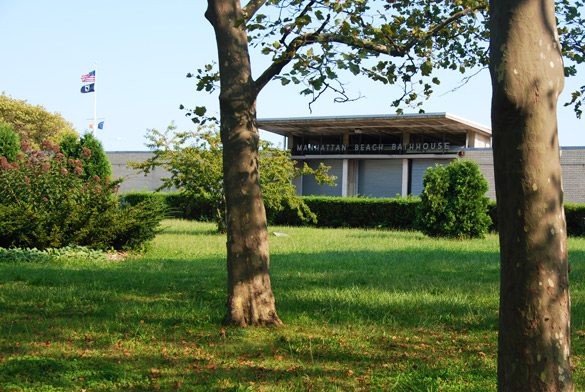City Seeks New Uses For Decrepit Manhattan Beach Bathhouse

The New York City Parks Department revealed the results of a three-year feasibility study, determining new potential uses for the Manhattan Beach bathhouse, a dilapidated Parks building that has been closed to the public for half a century.
The report, commissioned three years ago with a $125,000 budget allocation from Assemblyman Steven Cymbrowitz, recommends reactivating the building by turning it into an energy-efficient structure with upgraded Parks Department and NYPD administrative offices, sheltered and external storage space, larger bathrooms for beachgoers, fitness facilities and some solar power.
But the plan also features a 6,500 square foot section – approximately a third of the building – for unidentified community use, and the department is turning to residents to find out what they want.
At a press conference yesterday afternoon, Parks Commissioner Kevin Jeffrey joined Cymbrowitz to solicit ideas, some of which included a spa, restaurant or cafe, solar farm, cultural center and/or museum, environmental science laboratory, concert venue and, lo and behold, even a bathhouse, with lockers and showers.
The building opened in 1955, but closed 10 years later when it was determined that it could not adequately accommodate the number of people at the beach. With the exception of the restrooms, the building has since served as storage space for the Parks Department with meager administrative offices for Parks police, lifeguards and police units on summer patrol.
Local leaders have long been calling for the building’s rehabilitation, but community members have had divergent opinions on what should be done with the property.
The Manhattan Beach Community Group recommends turning the entire building into a solar farm that would feed back into the city’s system in exchange for lower electricity rates for the community.
According to MBCG President Ira Zalcman, who was interviewed by the Parks Department as they developed the study, his group consulted with solar companies about the idea, and they found that the building could house enough solar panels to cover 10 percent of the community’s needs.
“That estimate was made five years ago,” Zalcman said. “I’m sure the technology now could do even more.”
That idea was seconded by Cymbrowitz’s rival in the September 13 primary election, Ben Akselrod.
“I support the community’s proposal for solar panels on top of the building. In addition I propose to create a child friendly sports center inside the building to be used by children with adult supervision,” Akselrod said in a release issued earlier this month.
But the folks over at Manhattan Beach’s other civic group, the Manhattan Beach Neighborhood Association, are pushing a more traditional approach. President Alan Ditchek, who was also interviewed for the study, said he favors restoring it to a bathhouse.
“There should be showers and lockers. There should be enhanced toilet facilities, perhaps a small cafe in the front facing the beach. I thought the original concept of a bathhouse should be restored and improved. We felt you didn’t need to reinvent the wheel; a bath house is sorely needed there,” Ditchek said. “Families, when they come off the beach, should not be forced to use the water fountains to wash the sand off.”
The idea being pushed by Assemblyman Cymbrowitz is for a community cultural center that would give space over for art and history exhibitions, especially focused on the diverse immigrant communities of Southern Brooklyn.
That idea was seconded by MBNA’s executive boardmember Edmond Dweck.
“Basically [a cultural community center] seems to be something extremely acceptable and makes a lot of sense because of the demogaphics that live in our district,” Dweck said. “What Steve is looking to promote is what makes sense for the people. Not just the people of Manhattan Beach, but for the people of the entire district … Why not make Manhattan Beach some kind of destination point?”
But an “immigrant center,” as some in the neighborhood have started calling the proposal, is not what other Manhattan Beach leaders say they want, including both Ditchek and Zalcman, who rarely agree on anything.
“I don’t really understand what’s going to be there. A cultural center? To do what? To show off the history? I’m not sure how that helps the beachgoers,” Ditchek said.
“That’s not something for everybody,” agreed Zalcman. “Nobody – not one person in this community – has suggested an immigrant center. Not one person.”
During yesterday’s announcement, Cymbrowitz strenously emphasized that no plans were set in stone, and repeatedly said that the study was just the very first phase in a long process to finding a desirable use and prodding the city to move forward.
“These are not formal plans. This is the beginning of a discussion,” Cymbrowitz said. He repeated that phrase several times during the announcement.
Community Board 15 Chairperson Theresa Scavo noted that no one should get riled up about any of the proposals, as there’s at least one major obstacle to clear before the city moves forward on anything.
“There is no money for this. It’s a feasibility study to see what could be done but if there’s no money allocated, it’s not going very far,” Scavo said. “And I didn’t hear anything about a dollar amount.”
If you have a suggestion for new uses of the Manhattan Beach bathhouse, you may send them to Assemblyman Cymbrowitz who will forward them to the Parks Department.
